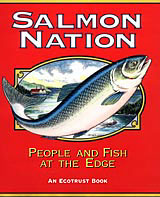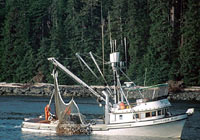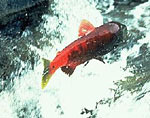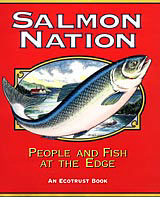
Salmon Nation
Edited by Edward C. Wolf
and Seth Zuckerman,
Ecotrust,
1999, 80 pages
This essay is excerpted from the new book Salmon Nation: People and Fish at the Edge, published by the environmental group Ecotrust.
Thirty percent of the world’s salmon now come from hatcheries, but wild fish account for only another twenty to thirty percent. Almost all of those wild fish come from waters around Alaska and British Columbia, northern waters where runs are mostly intact. These are the waters from which we harvest volumes comparable to those native people caught for thousands of years, that is, in those places largely unmanaged. The biggest share of the world’s salmon consumption, however — now forty to fifty percent — comes from farmed fish, salmon raised and fed artificially in net pens their entire lives.
The rise of salmon farming worldwide helps explain a puzzling paradox in the economic picture. We understand that salmon runs are troubled, even endangered in some places. Scarcity ought to dictate a high price, yet salmon fishermen, especially in recent years, have faced catastrophically low prices. Chinook salmon, for instance, have fallen from $5 a pound in the seventies to as little as $1 now. In recent years, Alaskan waters have been producing well, an increase in supply that is one factor in the low price, but not the dominant one. The biggest factor is that fish farming is flooding the market. In 1980, farmed salmon accounted for about 1 percent of all production, yet now we see it approaching fifty percent and climbing. The boom in farming has largely occurred in Norway, Scotland, and Chile, but is gaining a firm foothold in Washington’s Puget Sound and north along the southern B.C. coast in the waters surrounding Vancouver Island.
Like the hatchery boosters who preceded them, the fish farmers tell us aquaculture is good because artificially raised fish will take pressure off the beleaguered wild stocks and at the same time provide a hungry world with more food. Environmentalists have countered that the farms pollute, and that escapees (mostly Atlantic salmon) spread disease to and compete with wild runs. The environmentalists are right, but set aside their argument for a second. This is not, as the farmers would have it, a matter of a conflict between the environment and the economic realities of feeding the world. Salmon farming fails the economic test as well.

A salmon boat.
Does salmon farming take pressure off wild stocks? A commercial fisherman is not so much interested in the number of fish caught as the total income the catch generates. If a fisherman gets one-fifth the amount per fish, he must catch five times as many to maintain income, which regulations, of course, forbid. The results: increasing pressure on the regulations, increasing violation of them, and more broke fishers than there were a decade ago.
No Free Lunch
Yet this supply-demand-price haggle is but a small part of this picture, a narrow view of economics. Despite what you may have heard in the incessant jobs-versus-environment debate, biology respects an economic logic, ordering its market with the food chain. Species use resources according to their position in the chain. The chain serves no free lunch, particularly a free protein lunch, which is to say the protein of a farmed salmon does not come out of thin air. Animals low on the food chain eat plants. Cows eat carbohydrates in grass to make protein. Animals higher on the chain eat animals; they eat protein to make protein, losing as much as ninety percent of it in the process of maintaining life forces. This is why we don’t, as a rule, raise predators for food.
But we do farm salmon, and salmon are predators; they eat fish. Estimates of the metabolic loss vary, but there is always a loss. For instance, the Worldwatch Institute says it takes about five grams of fish protein — converted into fishmeal — to make a gram of farmed fish protein. Fishmeal is produced globally, especially from sardines and anchovies of South America and especially from herring from the North Pacific.
Worldwide, salmon aquaculture is sponsoring a secondary fishery that vacuums the ocean floor like a Shop Vac. Ocean fisheries historically have been damaging enough to the environment, but were typically at least somewhat selective to marketable species. However, when the end product is fishmeal, virtually everything that shows up in a net can be ground into the mix, setting the stage for a decimation of the system the way pulpwood set the stage for clearcuts. Wild salmon know how to graze this ocean system selectively, efficiently harvesting its protein for us. Our blundering nets know only how to destroy it and move on.

Run, salmon, run.
Photo by U.S. Fish and Wildlife Service.
Fish farming takes relatively low-cost protein, species once consumed directly by the world’s poor, reduces its volume by a factor of five, and sells it to the world’s wealthiest consumers. Meantime, wild fish, the few that are left, hatch to fingerlings and migrate to oceans only to find that the fishmeal trawlers have beaten them to their prey. This is the same logic that sent salmon fishers further to sea, but in this case, the trawlers are beating fish to fish, not other fishermen to fish.
We pay for this inefficient system in two ways. First, by relying upon a heavily capitalized, mechanized system that no longer uses the community labor of places like Namu, British Columbia (small coastal towns where life once revolved around salmon). The system renders them redundant; they become ghost towns as the few jobs that remain move to factory trawlers and centralized processing plants.
Second, most of the cost of this Rube Goldberg machine that has replaced nature’s intricate web comes by diminishing the productive capacity of nature. We live off the capital, not the interest. As market economists tell us, these are difficult costs to measure, these natural services that do nothing so much as make the world what it is. Difficult to measure, so we don’t really feel the loss — until they are gone.
All of this converges now on an emerging school of economic thought that seeks to assign dollar values to intact natural systems, a topic that has come to be known as “ecosystem services.” The salmon offer a classic case. Pacific salmon gave us a primary product — food — but in the bargain, they imported nutrients sufficient to feed a whole system. That system, in turn, raised more fish, an ecosystem service to which we could easily assign a dollar value today simply by adding up the costs of the hatchery system that replaced it. Except that the natural system worked.


